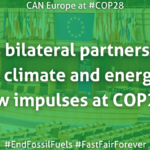The negotiations on the review of the Energy Efficiency Directive (EED) enter the final stretch today, with representatives of the European Parliament, the Council of Ministers and the European Commission meeting for the first informal ‘trialogue’ to negotiate an agreement on the new law.
Here is all you need to know about the institutions’ negotiating mandates, with colours indicating our assessement of the positions:
The European Parliament adopted its position on the EED review in January 2018. MEPs called for raising ambition by adopting a binding 35% energy efficiency target, but without national binding targets. They also voted in favour of a strong energy savings obligation (Article 7) with fewer loopholes compared to the Commission’s proposal. Unfortunately, the Parliament’s position does not include a 40% energy efficiency target for 2030, which is needed to match the Paris Agreement and to take full advantage of the benefits of energy savings.
The Energy Council reached an agreement their initial position on the EED review in June 2017. The Ministers adopted a weak 30% energy efficiency target and refrained from specifying whether it should be indicative or binding. The Ministers also proposed to add new loopholes in Article 7, significantly weakening the energy savings obligation. If the proposals on the energy savings requirement were to be adopted, post-2020 ambition would be significantly reduced compared to the already inadequate Commission’s proposal. That would severely undermine the EU’s commitments under the Paris Agreement. A group of progressive countries advocate for higher ambition, acknowledging that energy efficiency is indispensable for achieving the Paris Agreement goals.
Stocktake of the Parliament’s position
- An at least 35% binding energy efficiency target, but with no national binding targets
- A robust energy savings obligation under Article 7 with a long-term perspective. This includes provisions for closing the loophole that currently allows Member States to exclude the energy used in the transport sector from the calculation of the 1.5% objective after 2020. The rest of the “statistical tricks” currently allowed under Article 7 would be kept, as proposed by the Commission. This means that after 2020 loopholes could still reduce the energy savings to be delivered by up to 25%.
Stocktake of the Council’s general approach
- A 30% target without specifying if it is binding or indicative
- A very weak energy savings obligation (Article 7), which runs only until 2030 and includes provisions for increasing the overall use of loopholes. Member States could reduce the 1.5% annual objective to 1% from 2026. The ‘transport loophole’ could still be used after 2020, as proposed by the Commission. The negative impact of the other “statistical tricks” could increase from 25% to 35%. Member States would be allowed to carry over the excess of savings from the period up to 2020 to fulfil the requirements after 2020 with no limitations. That would happen at the expense of new measures that are could deliver additional savings.


